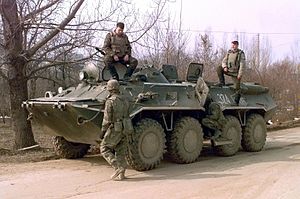|
|
| BTR-80 | |
|---|---|
 A Russian BTR-80 in Zvornik, Bosnia and Herzegovina |
|
| Type | Armoured personnel carrier |
| Place of origin | |
| Specifications | |
| Weight | 13.6 tonnes |
| Length | 7.65 m |
| Width | 2.90 m |
| Height | 2.35 m |
| Crew | 3 (+8 passengers) |
|
|
|
| Armor | Classified |
| Primary armament |
14.5mm KPVT machine gun |
| Secondary armament |
7.62mm PKT machine gun |
| Engine | diesel KamAZ-7403 260 hp (190 kW) |
| Power/weight | 19 hp/tonne |
| Suspension | wheeled 8×8 |
| Operational range |
600 km |
| Speed | 80 km/h, swim 9 km/h |
Description
The Soviets based the BTR-80 on the BTR-70 APC. It has a single 260-hp, V-8 turbocharged, water-cooled, diesel engine, an improvement over the twin gasoline engines installed in the BTR-60 and BTR-70 vehicles. The reconfigured rear portion of the hull accommodates a new, single engine. The Soviets removed the roof chamfers of the modified BTR-70, raised the rear, and squared off the rearward-sloping engine compartment. Standard equipment include TNPO vision blocks, optical devices TNP-B and TKN-3 for the driver and commander, an OU-3GA2M infra-red search light, six 81 mm smoke grenade launchers 902V "Tucha", a radioset (R-173 or R-163-50U), an intercom and hydrojets.Capabilities
The Soviets modified the truncated cone turret used on the BTR-70 for the BTR-80 by redesigning the mantlet. This allows the 14.5 mm and coaxial 7.62 mm machine guns to be elevated to a maximum of 60 degrees. This high angle of fire is useful in engaging targets on steep slopes, in urban fighting, and for engaging helicopters. The Soviets have also modified the design and positioning of the firings ports; the ports are now round, rather than tear-shaped, and have ball mounts similar to those used on the BMP-1. The forward firing ports now sit in angled recesses which allow the individual weapons to fire to the front of the vehicle.As indicated by armed conflicts, wheeled armored personnel carriers (APC's) are capable of considerably enhancing any army's combat potential. They are used to transport infantry units to the battlefield and engage in reconnaissance, combat security and patrolling, military cargo transportation, the towing of artillery guns and mortars. They are also used as medical and staff vehicles, mobile radio stations, recovery vehicles, repair shops, etc. In a number of cases they can accomplish fire support missions for infantry acting in combat formations. Developed by GAZ designers and manufactured since 1986 at Arzamas Engineering Plant, now known as AMZ joint stock company, the BTR-80 replaced previous versions, BTR-60PB and BTR-70. The BTR-80 armored personnel carrier is a four-axle, eight-wheeled vehicle, with all drive wheels, an independent suspension and water jet propulsion system. The APC (armoured personnel carrier) is capable of following tanks and negotiating emplacements, trenches and water obstacles. It is equipped with ten seats to accommodate the personnel.
The APC mounts devices for collective protection of the personnel from blast action and initial radiation during explosions of nuclear ammunition and from radioactive dust, bacteriological materials and toxic agents during the vehicle's operation on contaminated terrain. The vehicle is armed with a turret machine gun mount, designed to fight ground and low-flying air targets at ranges of up to 2,000 meters. The turret mount accommodates a 14.5 mm large-caliber machine gun (KPVT) and a coaxial 7.62 mm machine gun (PKT) with a traverse of 360° and an elevation of +60° to -4°. For battlefield illumination during night firing, there is an OU-3GA2M searchlight on the machine gun bracket. Six 3D6 smoke grenade launchers have been placed on the turret mount to provide smoke screens for camouflage purposes. The BTR-80's high mobility is ensured by the KamAZ-7403 turbocharged diesel engine, eight-wheel drive, the wheels' independent torsion suspension, large ground clearance, and centralized tire air pressure control system. The engine is a V-form eight-cylinder, with a maximum power of 260 hp at 2,600 rpm and a maximum torque of 785 Nm at 1,600–1,800 rpm.
The BTR-80 surpasses its foreign counterparts in the following areas:
- the ports for small arms fire by the infantry men are better arranged, adding to the APC's fire potential. The seven ports on its sides are turned forward, with one positioned in the hull front (straight ahead) and two on the roof (the latter allow for fire at high-set targets). Two ports enable machine gun fire;
- the ports are equipped with spherical bearings that enable firing from inside the vehicle without depressurizing the fighting compartment even on contaminated terrain, as the filter-ventilation unit supplies purified air inside the APC;
- the front projection of the APC hull ensures protection of the infantry men from 7.62 mm assault rifle and also 12.7 mm machine gun fire;
- the APC is equipped with an anti-roll-down mechanism, which prevents the rolling down of the APC, when it comes to a halt or starts moving on grades, and facilitates the driver's actions in mountainous areas;
- the APC can negotiate water barriers in its stride without any preliminary preparation. Owing to its water jet propulsion system, the APC can move easily across shallow waters and overgrown water bodies as it is not damaged in this case. The armored personnel carrier can be transported by any means of ground, sea or air transport.
The redesigned side doors are split horizontally. The upper portion opens forward; this gives dismounting troops some protection against small arms fire from the front of the vehicle. The lower portion opens down, forming a step. Six smoke grenade projectors are mounted on the rear of the turret.


Show Konversi KodeHide Konversi Kode Show EmoticonHide Emoticon